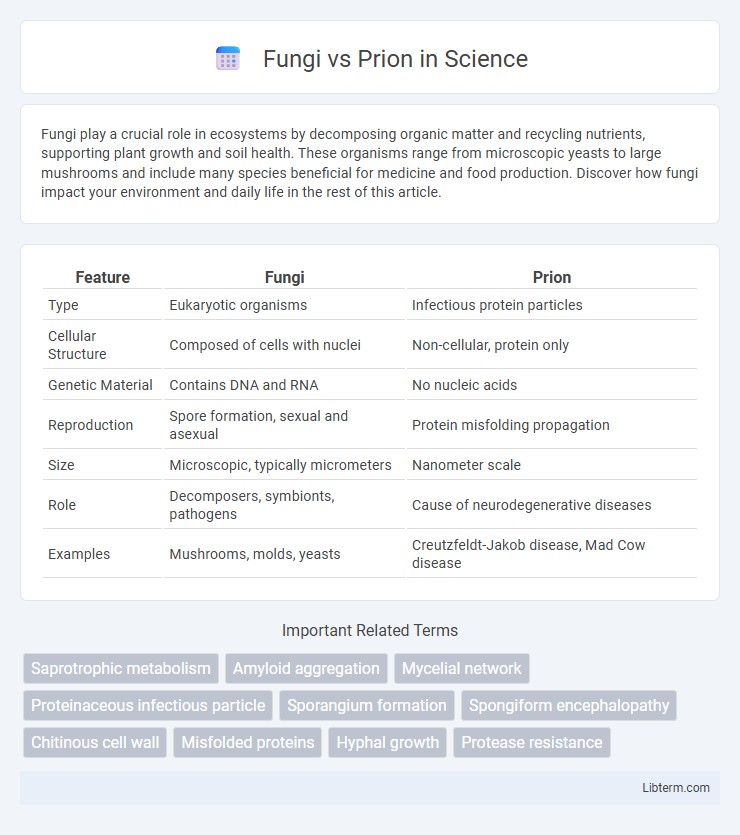Fungi play a crucial role in ecosystems by decomposing organic matter and recycling nutrients, supporting plant growth and soil health. These organisms range from microscopic yeasts to large mushrooms and include many species beneficial for medicine and food production. Discover how fungi impact your environment and daily life in the rest of this article.
Table of Comparison
| Feature | Fungi | Prion |
|---|---|---|
| Type | Eukaryotic organisms | Infectious protein particles |
| Cellular Structure | Composed of cells with nuclei | Non-cellular, protein only |
| Genetic Material | Contains DNA and RNA | No nucleic acids |
| Reproduction | Spore formation, sexual and asexual | Protein misfolding propagation |
| Size | Microscopic, typically micrometers | Nanometer scale |
| Role | Decomposers, symbionts, pathogens | Cause of neurodegenerative diseases |
| Examples | Mushrooms, molds, yeasts | Creutzfeldt-Jakob disease, Mad Cow disease |
Introduction to Fungi and Prions
Fungi are eukaryotic organisms encompassing yeasts, molds, and mushrooms, characterized by chitin-containing cell walls and heterotrophic nutrition through absorption. Prions are infectious agents composed solely of misfolded protein, lacking nucleic acids, and capable of inducing neurodegenerative diseases by altering normal protein structures in host organisms. Both fungi and prions play significant roles in health and disease, with fungi acting as pathogens or decomposers and prions causing fatal transmissible spongiform encephalopathies.
Structural Differences Between Fungi and Prions
Fungi are eukaryotic organisms with complex cellular structures including cell walls composed primarily of chitin, nuclei, mitochondria, and cytoplasm. Prions are misfolded proteins lacking cellular structure, composed solely of abnormally folded prion proteins (PrP) that induce pathogenic conformational changes in normal proteins. Unlike fungi, prions have no DNA, RNA, or cellular components and exist as infectious protein agents causing neurodegenerative diseases.
Life Cycle and Reproduction
Fungi reproduce through both sexual and asexual spores, involving complex life cycles that include haploid and diploid stages as well as processes like meiosis and mitosis. In contrast, prions lack cellular structures and genetic material, reproducing by inducing misfolding of normal proteins, which propagates their infectious form without traditional replication or life cycle phases. This fundamental difference highlights fungi as living organisms with defined reproductive cycles, while prions are infectious proteins that replicate through protein conformational change.
Pathogenic Mechanisms
Fungi cause disease through mechanisms including the production of toxins, tissue invasion, and immune system evasion, leading to infections such as candidiasis and aspergillosis. Prions induce neurodegenerative diseases by promoting the misfolding of normal proteins into abnormal, insoluble forms that aggregate and cause brain tissue damage, exemplified by Creutzfeldt-Jakob disease. While fungal pathogens actively reproduce and elicit immune responses, prions are infectious protein particles that propagate without nucleic acids and evade conventional immune detection.
Diseases Caused by Fungi vs Prions
Fungi cause a variety of diseases such as athlete's foot, ringworm, and histoplasmosis, typically affecting the skin, lungs, and immune systems of humans. Prions, abnormal infectious proteins, are responsible for fatal neurodegenerative diseases like Creutzfeldt-Jakob disease and bovine spongiform encephalopathy, which damage brain tissue and lead to severe cognitive decline. Unlike fungal infections that often respond to antifungal treatments, prion diseases currently have no cure and are uniformly fatal.
Diagnostic Methods
Fungi infections are commonly diagnosed through direct microscopy, culture techniques, and molecular methods like PCR to identify fungal DNA. Prion diseases require more specialized diagnostics such as brain biopsy, detection of protease-resistant prion protein via Western blot, and cerebrospinal fluid assays for biomarkers like 14-3-3 protein. Advanced imaging techniques including MRI can aid in prion diagnosis but are not definitive compared to fungal diagnostic protocols.
Treatment and Management Options
Fungal infections are treated using antifungal medications such as azoles, echinocandins, and polyenes, which target fungal cell components to inhibit growth and replication. Prion diseases lack effective treatments; management focuses on supportive care to alleviate symptoms and maintain patient comfort. Ongoing research explores experimental therapies for prions, but no FDA-approved cures currently exist.
Environmental Impact and Distribution
Fungi play a critical role in environmental nutrient cycling by decomposing organic matter and forming symbiotic relationships with plants, which enhances soil fertility and ecosystem stability. Prions, unlike fungi, do not participate in nutrient cycling but pose significant environmental risks due to their persistence and ability to cause neurodegenerative diseases in wildlife and livestock, affecting biodiversity and ecosystem health. Fungi are widely distributed across diverse ecosystems globally, thriving in soil, decaying matter, and symbiotic niches, whereas prions are primarily detected in infected animals and contaminated environments, with limited natural dispersal outside host species.
Comparative Role in Human Health
Fungi are eukaryotic organisms that can cause infections such as athlete's foot, candidiasis, and aspergillosis, exhibiting both opportunistic and primary pathogenic roles in human health. Prions are misfolded proteins responsible for fatal neurodegenerative diseases like Creutzfeldt-Jakob disease and kuru, characterized by their ability to induce abnormal folding of native proteins leading to brain damage. While fungi impact human health through infections and immune response interactions, prions uniquely contribute to transmissible spongiform encephalopathies without involving nucleic acids or typical infectious agents.
Current Research and Future Perspectives
Current research on fungi explores their diverse metabolic pathways and potential applications in biotechnology, including antibiotic production and environmental remediation. Prion studies focus on understanding the molecular mechanisms of protein misfolding and transmissible spongiform encephalopathies, aiming to develop targeted therapeutics and diagnostic tools. Future perspectives emphasize the integration of genomic and proteomic technologies to uncover novel fungal bioactive compounds and prion-related biomarkers for disease prevention and treatment.
Fungi Infographic

 libterm.com
libterm.com